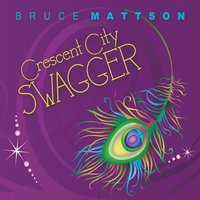 Bruce Mattson’s new, mostly instrumental, Crescent City Swagger CD is a fantastic gumbo mix of blues, stride, and Louisiana flavored music. Mattson and his band mates play a huge, polished sound on this album, and it’s very entertaining from beginning to end. Mattson’s piano work adds authentic New Orleans colors and tones to many things on this album, and that keeps it sounding different from anybody else in the local scene indulges in. He’s also a hell of a Hammond B3 organ player.
Bruce Mattson’s new, mostly instrumental, Crescent City Swagger CD is a fantastic gumbo mix of blues, stride, and Louisiana flavored music. Mattson and his band mates play a huge, polished sound on this album, and it’s very entertaining from beginning to end. Mattson’s piano work adds authentic New Orleans colors and tones to many things on this album, and that keeps it sounding different from anybody else in the local scene indulges in. He’s also a hell of a Hammond B3 organ player.
Mattson wrote and composed everything on this album. Opening track “Westwego Wedding March” is a stomping, action packed piano boogie instrumental blues. Mattson hits those piano notes like a painter painting a portrait. He injects a cool melodic line that dances with the counter melody from Doug James’s baritone saxophone. The sprightly melodies from each conjure an energetic party vibe. They make it easy to picture people dancing inside a New Orleans night club or a house party during an earlier, more colorful time in American music.
Second track “After The Flood” features Willie J. Laws on vocals. Laws pours heart and soul into his microphone, making his voice flow with the powerful emotion that runs turbo charged through this number. Mattson couldn’t have found a more appropriate lead vocalist here if he had searched the earth for years. Laws reaches emotional and musical highs by the end of each verse. That vocal is punctuated by some perfectly timed Mattson organ swirls and drums and Tony D’Amico’s bass. James Fidlon plays an incendiary guitar phrase while Charles Neville blows a wide, mellow tenor sax line in the backdrop. It’s simply a huge number with a lot of coolness going on inside of it.
“The Peacock Principle” is a breezy, jazzy affair. It’s blues spread out, smoothly and thinly. Mattson’s organ swirls create the backdrop for Ben Smeltzer’s vibrant trombone workout. This bone has a brassy shine, making it stand tall and proud. Mattson comes back into the piece in a major way, his hands strutting around his organ keys in a mellow groove. It’s simply a fun, groovy dance between bone and keys.
“Greasy Street” offers more of Mattson’s Hammond B3 organ work. Here, Mattson hits several high organ notes in a variety of intervals to make for one elegant expression. He breathes a lot of extra life into this piece when he plays notes that seem to puff with energy. Mattson also plays electric piano and guitar here too while someone named Ephraim lays down bracing, feisty drums.
“Your Uncle’s Monkey” gets a bit jazzy in its easefully smooth deliveries. Greg Takemoto blows a strong alto sax line, twisting his melodic line into something pretty as a sunny day and as sweet as candy. Mattson, meanwhile, gets into some intricate note patterns, making his melodic line dance, dip, spin, and spiral. Listeners might envision a hip, 1950s, beatnik crowd inside an upscale New York City bar bobbing their heads to this action.
Tony Medeiros offers a smooth, funky vocal line on “Wheels Up And Gone.” He sings it playfully and soulfully, making his voice an interesting instrument in this song. Doug James’s baritone sax offers yet another layer of rich melodic texture. Amadee Castenell plays a sweet smooth tenor sax line in the midst of this New Orleans flavored gumbo. With everything layered around Mattson’s free, bouncy piano boogie, this song struts its way across a dance floor during an all night house party.
“Swamp Slunker” is as cool as its title sounds. Rich, thick bari sax notes played by some guy named Mark Earley make this one as tasty as gourmet coffee with a sweet pastry, fresh from the pastry shop. Earley blows this treat of a melodic line in a hip, swaggering pattern. Mattson supports Earley with a little push from his organ swirls and bossy piano tinkling while drummer Ephraim Lowell holds the whole thing afloat with his persistent fills.
Willie J. Laws presses a smoky, growling melodic phrase out of his electric guitar on “Rooster Shoes.” Mattson rocks his organ chords, pressing out some howling good phrases. Laws and Mattson dance around each other’s lines like a friendly dance contest, each inspiring the other to come up with something even cooler in the next section. Mark Teixeira goes into a solo, a funky break from the melodic action, before the organist and the guitarist climb ever higher into clouds of cool.
A number titled “Professor Creole’s Original Groove Elixir” jumps out of the gate with Bob Paluccio’s drum work. The drum beat kick starts the action. Barry Fitzpatrick plays some fetching, funky guitar riffs while Ben Smeltzer’s handles the trombone, making his horn sound smooth, restrained, turning its big, brassy sound into something he can emit as softly as a smaller horn, making its potential for volume a slow burning flame, simmering just below the surface. Mattson’s organ line practically glides over all of this, something running free and wild amidst the fine musical touches from all around him. As cool as all of this is, one can also hear it as a polite conversation between four refined gentleman, each taking his turn responding to what the other has to say.
“Wake Up Moses” is another Willie J. Laws vocal number. Laws comes in smooth and slow before belting with the spiritual ebullience of a choir. Man, it would be a crime if Mr. Laws didn’t start winning local blues awards this year. Laws’s strutting vocal aplomb and Mattson’s New Orleans piano boogie combine into one fun, authentic flavoring from The Big Easy. This is another one that makes it easy to imagine an all night club packed with frenetic dancers. Charles Neville and Amadee Castenell blow tenor sax to great effect, both of them blowing a lot of playful lines that dance around the beat, adding to the parade of strutting entertainment that this piece is.
Close out track “Hymn For Veronica” is a jazzy, pretty slice of New Orleans blues, a number lead by Amadee Castenell’s tender, floating tenor sax line. Castenell’s melody moves like a feather high in the sky, gliding on some invisible strength in a warm summer breeze. The saxophonist makes his line skip along jauntily, a sound suggesting something special is about to come to an end. It’s a perfect close out to this Mattson album. Mattson’s piano and organ backdrop, along with Malcolm Stuckey’s bass line and Bob Paluccio’s drum support, encase that horn line with a gust of wind that carries it far. It also feels a bit sad because the album is almost over, and it’s one of those albums that you wish could be twice as long because it offers so much fun and so much musical substance.
Mattson accomplishes something significant on this Crescent City Swagger album. He creates a lofty vision of New Orleans flavored blues, jazz, and swing while offering something that serious fans of this music can really sink their teeth into. Many New England blues fans will likely be returning to this album for many a repeated listening.

